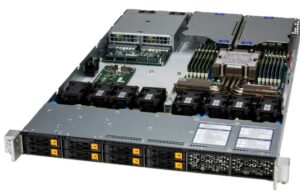In the modern data infrastructure landscape, the demand for storage solutions that are lightning-fast, scalable, and cost-effective is relentless. Businesses across every sector are grappling with ever-growing data volumes, the complexities of AI/ML workloads, and the need to accelerate critical applications. At Lightbits, we are committed to pushing the boundaries of what’s possible in disaggregated NVMe over TCP storage. It is with immense excitement that we announce a significant milestone in our journey: the successful qualification of the Supermicro CloudDC A+ Server AS-1116CS-TN, powered by the AMD EPYC 9455 48-Core Processor.
sector are grappling with ever-growing data volumes, the complexities of AI/ML workloads, and the need to accelerate critical applications. At Lightbits, we are committed to pushing the boundaries of what’s possible in disaggregated NVMe over TCP storage. It is with immense excitement that we announce a significant milestone in our journey: the successful qualification of the Supermicro CloudDC A+ Server AS-1116CS-TN, powered by the AMD EPYC 9455 48-Core Processor.
This certification represents a powerful alliance between two industry leaders dedicated to innovation. The rigorous testing and qualification, conducted at Supermicro’s advanced labs, demonstrate the exceptional capabilities of this integrated solution, delivering unprecedented performance metrics that will empower organizations to modernize their data centers.
Qualification Process
Our collaboration with Supermicro goes far beyond simply integrating our software with their hardware. It’s a testament to a shared vision of delivering robust, high-performance, and reliable end-to-end solutions.
The setup at Supermicro’s lab was configured to simulate a production environment. This included:
- Lightbits Cluster: a 3-node Lightbits ver.3.15.1 cluster, demonstrating the inherent scalability and resilience of our platform. Crucially, replication was enabled across the cluster, ensuring data high availability and integrity—a critical feature for any enterprise-grade storage solution.
- Client Nodes: To generate the necessary load and accurately measure performance, multiple client nodes were connected to the Lightbits cluster. This enabled us to simulate a diverse range of application workloads, from intensive random I/O for databases to large sequential transfers for AI/ML training.
- State-of-the-Art Hardware: Lightbits software was installed on the Supermicro AS-1116CS-TN server. This single-socket server is a powerhouse, specifically designed for high-performance computing and storage applications. Its compatibility with the latest generation of PCIe Gen5 NVMe SSDs and high-speed networking makes it an ideal platform for Lightbits.
The choice of the AMD EPYC 9455 48-Core Processor was a strategic one. AMD EPYC processors are renowned for their high core count, exceptional memory bandwidth, and robust PCIe connectivity – all critical attributes for maximizing the performance of disaggregated NVMe/TCP storage. The 48 cores of the EPYC 9455 provide ample computational power to handle the sophisticated Lightbits software stack, manage network I/O, and orchestrate data operations with minimal latency. This synergy between Lightbits’ software-defined capabilities and the raw power of AMD EPYC processors allows for unparalleled efficiency and throughput.
Unpacking the Numbers
The results of this rigorous qualification process are nothing short of spectacular. These numbers are not just benchmarks; they are a clear indication of the transformative power this solution brings to demanding workloads.

- 3.6 Million IOPS for 4K Random Read: For performance-sensitive applications, achieving 3.6 million IOPS for 4K random reads enables faster data access, resulting in improved responsiveness and a superior user experience. Imagine the impact on financial trading platforms, e-commerce sites, or real-time analytics dashboards. This level of random read performance directly translates to accelerating the most I/O-intensive database operations, reducing query times, and enabling higher transaction rates.
- 1.6 Million IOPS for 4K Random Write: While reads are crucial, efficient writes are equally important for data integrity and application performance. Achieving 1.6 million IOPS for 4K random writes showcases the solution’s robust write capabilities, essential for logging, journaling, and rapidly updating frequently changing datasets. This is important for applications such as distributed file systems, NoSQL databases, and caching layers.
- 54.7 GB/s for 128K Sequential Read Bandwidth: This colossal bandwidth across three connected compute nodes demonstrates the system’s capacity for high-throughput data transfer, making it ideal for workloads that require reading large blocks of data sequentially. Think of AI/ML training, video rendering, scientific simulations, or big data analytics. This bandwidth enables organizations to process massive datasets in a fraction of the time, unlocking new possibilities in data-driven innovation.
- 16.7 GB/s for 128K Sequential Write Bandwidth: This is crucial for applications that generate large sequential data streams, such as data ingestion pipelines, backup and recovery operations, and data warehousing. For example, in a genomics research lab, rapidly writing large sequencing files is critical. In a media production house, efficiently storing high-resolution video streams is paramount. This robust sequential write performance ensures that data can be captured and stored as quickly as it is generated, preventing backlogs and enabling real-time data processing.
Lightbits and Supermicro – A Full End-to-End Solution
The successful outcome, as evidenced in this qualification, is a testament to the strategic collaboration between Lightbits and Supermicro. Our engineers worked hand-in-hand, optimizing every layer of the stack – from the hardware design of the Supermicro servers and the firmware of the NVMe SSDs to the Lightbits software and network configurations. This deep level of integration ensures that customers receive a fully optimized, turn-key solution, minimizing deployment complexity and maximizing performance from day one.
This partnership provides a comprehensive end-to-end solution for a wide range of workloads, including databases, AI and ML, Virtualization, Financial, e-commerce, and other applications.
The beauty of Lightbits’ disaggregated NVMe/TCP architecture on Supermicro servers lies in its flexibility and efficiency. By separating compute from storage, organizations can scale each resource independently, eliminating stranded capacity and optimizing infrastructure costs. NVMe/TCP leverages standard Ethernet networks, avoiding the need for expensive and complex Fibre Channel fabrics, further simplifying deployment and reducing TCO.
Watch for more product innovations as we continue to push the boundaries of what’s possible in the world of disaggregated, high-performance storage.
Contact us today to learn more about how Lightbits on Supermicro AMD-based servers can transform your data center.


